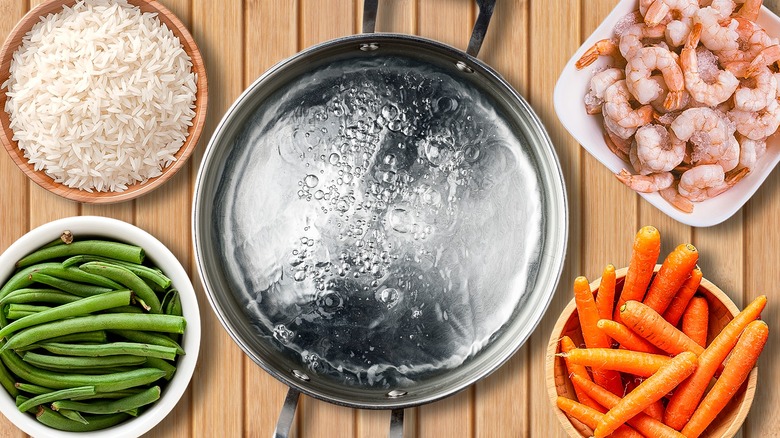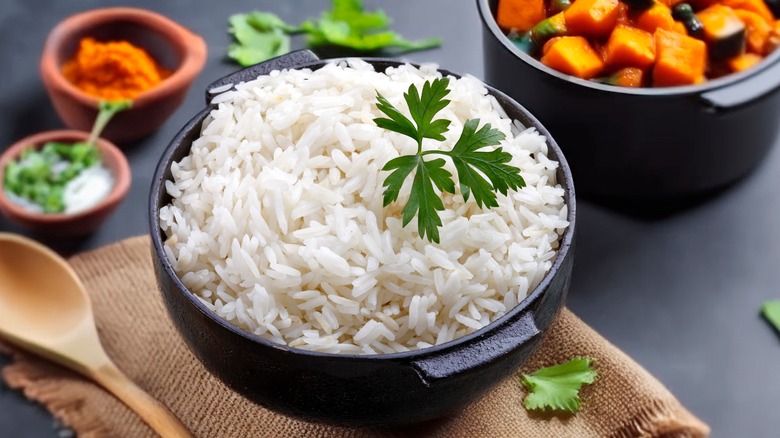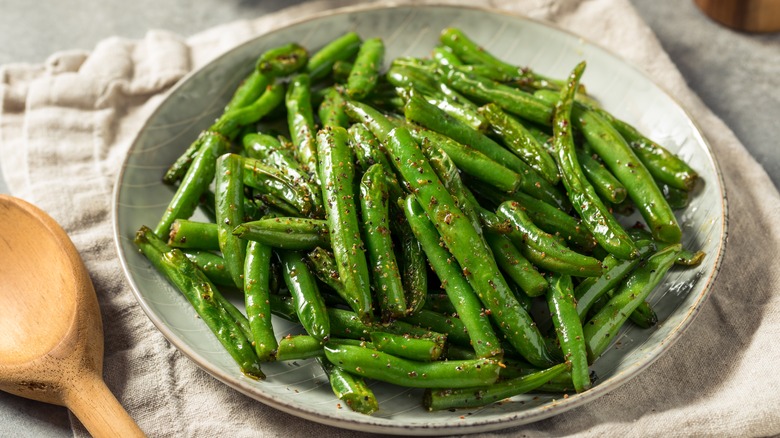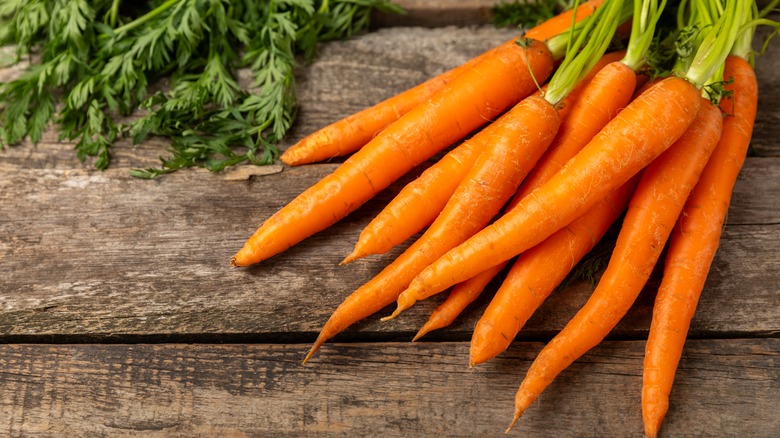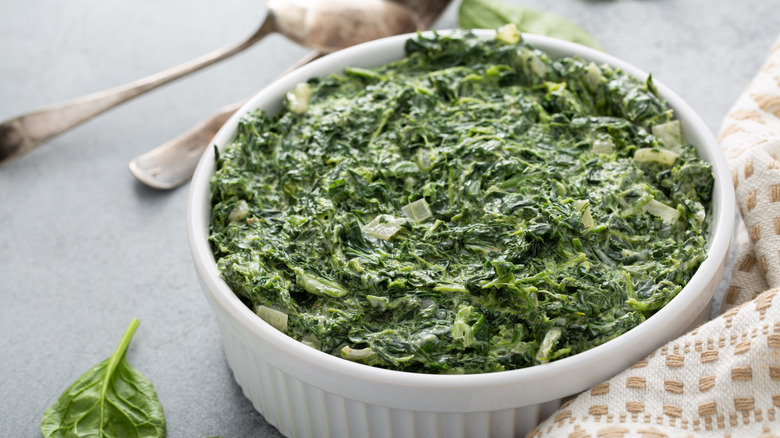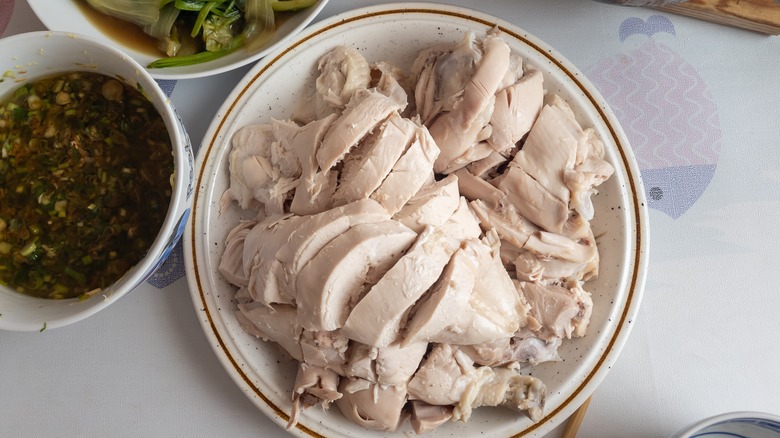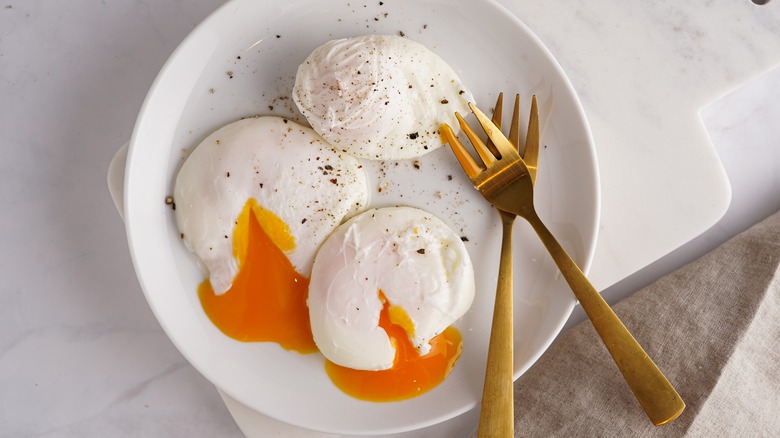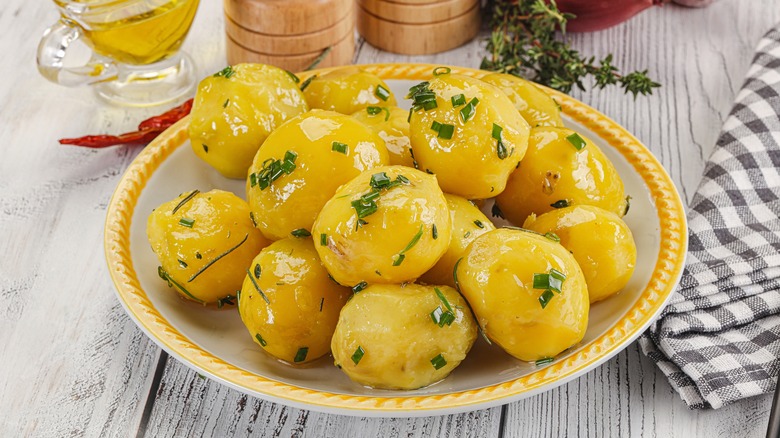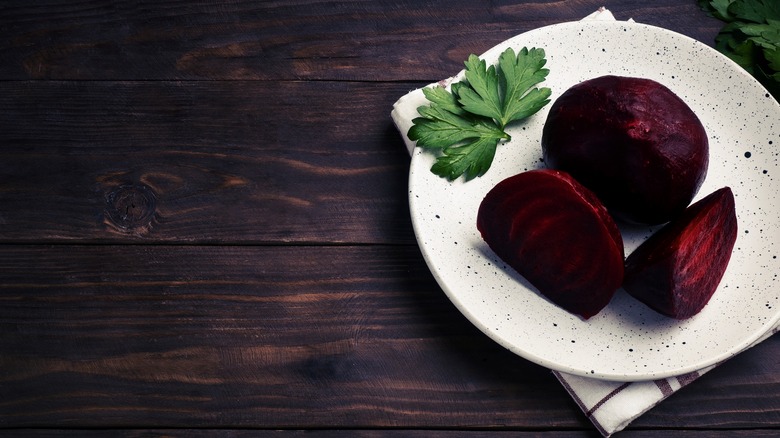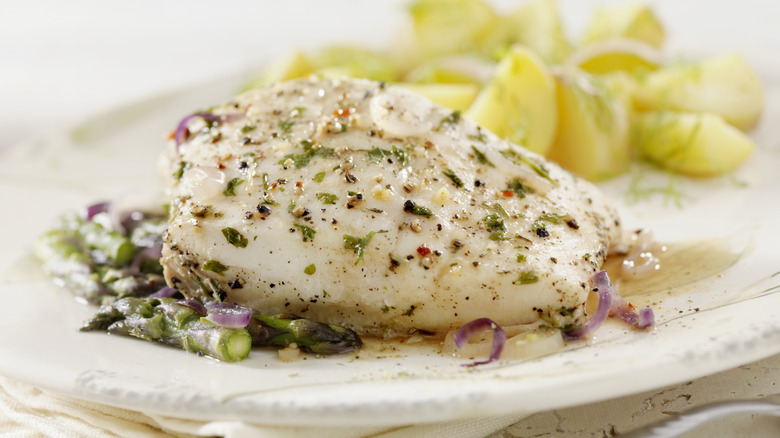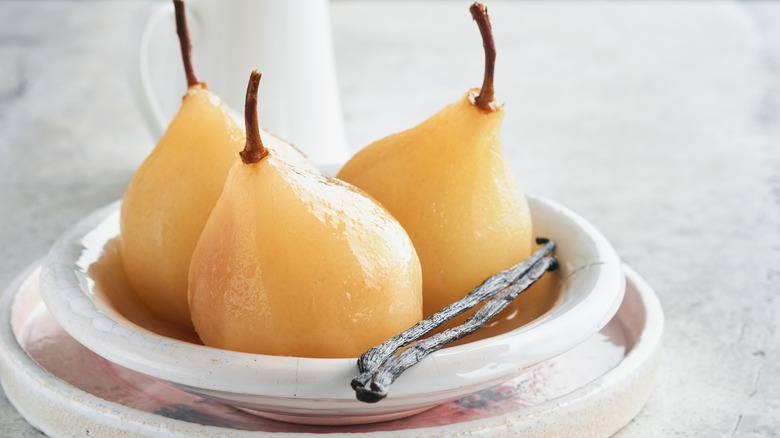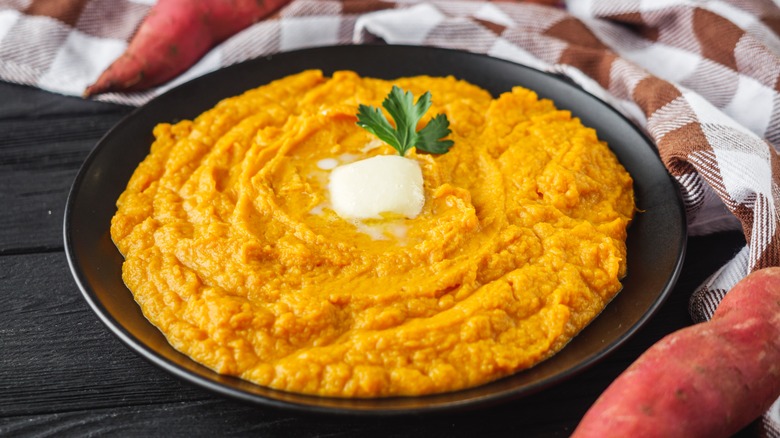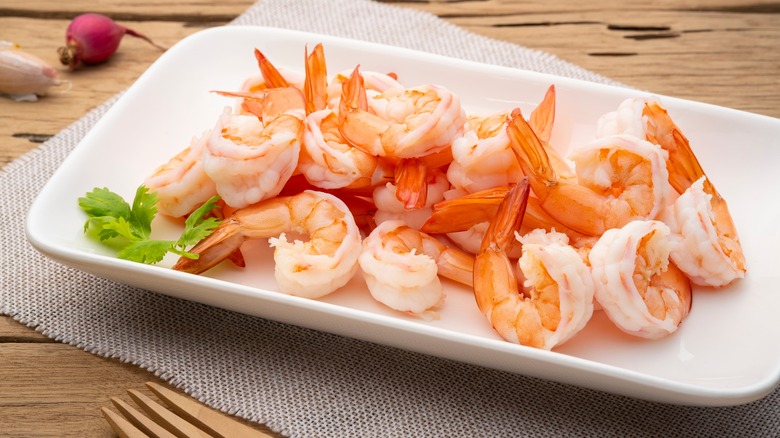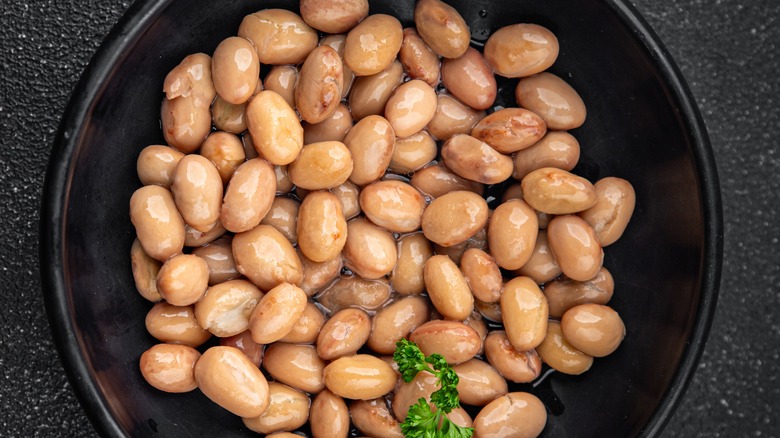13 Foods That Are Better When Cooked In Water
Using water may be one of the earliest methods of cooking food — dating back 30,000 years, according to some paleontologists — but it isn't showing any signs of going out of fashion yet. Every home cook should learn the simple techniques of boiling, poaching, and steaming food using water. These methods are effective ways to cook a quick meal for the whole family without adding extra fat or worrying about your food burning. Cooking with water also enables food to cook more evenly and quickly, eliminating the risk of over-drying. As for additional benefits, nutrients are often retained better when cooking with water, meaning a healthier meal overall.
There are many foods that taste their best after being cooked in water, from starchy staples such as rice and potatoes to poultry and even fruit. Food cooked in water can also soak up the flavors of the liquid, so you can add herbs and spices to infuse your food as it cooks. Ready to explore the different types of food that are better when cooked in water? Grab your apron and let's dive in.
Rice
Rice is one of the most widely eaten foods in the world, and is a dietary staple for roughly half of the planet. But cooking it perfectly is no easy task, and soggy, mushy rice is a common outcome among home cooks.
If you are looking for a bowl of perfectly fluffy rice, boiling it is the best way to achieve that result. Submerging every grain of rice in the water as it simmers away provides an even and consistent heat, so some of the grains of rice won't end up being more cooked than others. If you cook it properly, the rice should not stick together either.
The mistake many people make when cooking rice this way is overfilling their pot with water. Instead, add less water, so that it will all be absorbed during the cooking process. For white rice, around 1 cm of water above the rice is what you are aiming for. If you are boiling brown rice, stick to 3 cm above. After bringing the rice to a boil, simmer it for 10 minutes (white rice) or 20 minutes (brown rice). Once your timer goes off, the water should have just disappeared, leaving you with beautifully cooked rice.
Green beans
Eating certain fruits and vegetables raw is the best way to enjoy their vibrant taste and get the most out of them nutritionally. However, green beans don't fall into that category. Cooking them will actually improve your eating experience.
Though you can eat green beans raw, they contain a compound called lectin, which is present in all legumes. Lectins are difficult to digest and can cause bloating and digestive discomfort. The good news is that boiling green beans will reduce the negative effects of the lectins considerably.
To cook the green beans perfectly in water, trim the ends so that the beans are all roughly the same size. Then add them to salted water and simmer for five minutes. When you remove them, they should have a crunchy texture but not be too hard to bite into. Enjoy them simply dressed with a sprinkling of salt and a tab of butter.
Carrots
Growing up, you may have heard that carrots were good for your eyesight, and as it turns out, that's true. A compound called beta-carotene is not only responsible for the vibrant orange color of carrots, but also for their significant nutritional benefits. In addition to improved eye health, these include better lung function, clearer skin, and protection from certain types of cancer. Interestingly, these benefits are even greater in cooked carrots than if you eat them raw.
A crucial step when boiling carrots is to make sure you don't overcook them. You want them to be tender but with a slight crunch, not soggy. The best way to achieve this is to slice them into uniform pieces before boiling them for around four to five minutes. Be sure to check them with a fork regularly to catch them before they get mushy.
Cooking your carrots in water will allow you to enjoy them and their inherently sweet flavor best, while also getting the greatest health benefits.
Spinach
Adding spinach to your diet is a great way to up your nutrition, and raw spinach leaves make a nice base for a healthy salad. However, choosing to boil your spinach instead can have a surprising benefit.
Raw spinach, though packed with nutrients, also contains oxalates which could potentially cause health problems. Oxalates block the absorption of calcium, and over time could cause kidney stones. Boiling spinach for a few minutes will reduce the levels of oxalate significantly, meaning you can enjoy its nutrient-dense goodness without worrying about oxalate buildup.
To prepare your spinach, add it to boiling water and cook for one to two minutes until it becomes wilted. It will be waterlogged, so be sure to drain it really well before seasoning and serving. Bear in mind that when boiling spinach, it will shrink significantly, leaving you with only about 10% of the volume you started with. While this can be a bit of a shock if you're not expecting it — especially if you are cooking for a crowd — the nutrients will be packed into a much smaller portion of food, making it easier to eat a substantial amount.
Chicken
When cooking chicken breast, many of us automatically turn to roasting or pan-frying. But you may be missing out by ignoring a classic means of preparation: poaching. A term typically associated with eggs, poaching means cooking food in a liquid at around 140 to 180 degrees Fahrenheit, which is significantly less than the 212 degrees Fahrenheit needed for boiling. Poaching chicken properly is a great way to cook it evenly and ensure it remains moist.
The key to flavorful poached chicken is to keep it at a consistent simmer, rather than allowing it to come to a boil. The result will be a tender piece of poultry that will melt in your mouth. Compared to other cooking methods, poached chicken also has the advantage of not requiring you to add any fat, allowing you to keep the calories to a minimum.
The next time you are planning to cook chicken breasts, don't bother turning the oven on. Poach them on the stove instead and enjoy a juicy, healthy version that could become your go-to midweek dinner.
Eggs
When it comes to cooking eggs, whether for breakfast, lunch, or dinner, there are so many options. But two main methods of preparation — boiling and poaching — result in delicious low-calorie eggs cooked without any oil or additional fats.
Packed with protein and several vitamins, boiled eggs — both soft and hard — are a wonderful light meal or snack. And they can be prepared quickly. Simply boil them in water (in their shells) for five to 10 minutes, depending on how much you want the yolk to ooze out. A quicker boil will leave you with a runny yolk while a longer one will leave the egg hard-boiled.
The other option is to poach your eggs, which means cracking them into water and simmering them for a few minutes. Though perfectly poached eggs are famously tricky, a little bit of practice will result in a delicious poached egg on your plate.
Potatoes
Boiling potatoes is a fantastic way to enjoy them, either as-is with plenty of fresh herbs and spices, or eventually as perfect mashed potatoes or in potato salad.
To boil potatoes successfully, it is important to have similar-sized pieces. If you are using baby potatoes, select ones that are roughly the same size, and for larger potatoes, cut them into uniform pieces. This prevents some pieces from overcooking while others remain raw. The cooking time will vary depending on the variety of potatoes and their size, but on average they will take between 10 and 20 minutes to boil.
If you are concerned about some of the nutrients escaping into the water, choose organic potatoes and then keep the skins on, as this will help retain some vitamins and minerals. You can also save the water you cook them in to add to soups or as extra liquid for mashed potatoes.
Beets
Beets have long been considered a superfood and are an ingredient we could all benefit from eating more of. Their deep color is a giveaway as to their nutritional benefits, as it is a sign of the many plant-based compounds within the vegetable. While beets can be eaten raw as an earthy-tasting snack, boiling them mellows their flavor and brings out their natural sweetness, making them more palatable.
Cooking your beets in water is easy and pretty hands-off. Depending on their size, boil them for 20 to 40 minutes, and check them on and off towards the end of their cook time to ensure they aren't still raw.
Preparing the vibrantly colored vegetable in this manner will bring out the beautiful sweet notes of the beetroot. Try adding the cooked beets to a salad or simply eat them as a healthy snack with a little vinegar for a bit of tang.
Fish
You may be used to baking or pan-searing, but poaching fish in water is a technique that results in a perfectly cooked meal every time. Fish is much more delicate compared to meat, and needs to be cooked in a way that treats it appropriately. By simmering the fish very gently, you will reduce the chances of it drying out from being overcooked.
Poaching fish is easy, and the poaching liquor is customizable too. You can add herbs, spices, and even alcohol to the water to infuse it with flavor so that your dish has a delicious taste to match its appetizing texture. A bonus of poaching fish is that you can use the poaching liquid to make a sauce, meaning any fishy goodness that has leached into the water won't be lost.
Fillets will take between four and eight minutes to poach, depending on their size. Don't be tempted to crank up the heat; poaching liquid should simmer, and just barely. Though you can keep the fish skin on if you wish, it is not going to crisp up, so it may not be particularly enjoyable to eat. It is packed with nutrients though, so if you don't mind the texture, go for it!
Pears
Poached pears are a classic dessert that allows you to have healthy pieces of fruit in a more lavish way. Though pears taste perfectly good raw, poaching them gives them a little more punch. The process is quick and easy, so if you have a few extra minutes the next time you consider making a fruit salad for dessert, try poaching pears instead.
Because you can flavor your water for poaching, this dessert is easy to customize. Sugar is often added to bring out the natural sweetness of the pear, along with spices such as star anise or nutmeg. Vanilla is another classic option, alongside some citrus zest to add some zing.
Cutting the pears in half will reduce the cooking time significantly, and they should only take 20 minutes to poach. Check them regularly with a fork to make sure they don't end up so soft that they break apart. Serve your delicious poached pears with a drizzle of honey, chocolate sauce, or a spoonful of whipped cream for a decadent dessert with virtually no effort.
Sweet potatoes
Sweet potatoes have become a bit of a sensation in the last decade or so, nudging regular potatoes out of the limelight with their bright orange flesh and plentiful vitamins and minerals. Though many people like to bake or fry their sweet potatoes, boiling is a better option nutritionally, and still highlights their distinctive sweet flavor.
One of the stand-out nutrients in sweet potatoes is beta-carotene, the same antioxidant that makes carrots a superstar food. Antioxidants protect the body from free radicals, which cause all sorts of issues related to aging and disease. Though some beta-carotene is lost during every type of cooking process, boiling is thought to preserve more of this crucial compound than baking. Boiling also means that no fat needs to be added, which may be important to some.
Sweet potatoes can be boiled whole or diced, but obviously, the cooking times will be significantly different. A large whole sweet potato can take close to an hour to cook through, whereas one-inch cubes will be ready in less than 15 minutes. Once you have boiled your sweet potatoes, you can enjoy them as they are, or mash them up with a little butter for a side dish that is decadent and healthy at the same time.
Shrimp
Shrimp are a wonderful seafood delicacy that makes a great appetizer or entree with their delicate flavor. If you have ever enjoyed a classic shrimp cocktail, the shrimp were likely boiled, creating the perfect juicy texture. Boiling shrimp in water is an easy way to cook them and only takes a few minutes.
If you have never cooked shrimp before, you may be surprised that they are gray when raw, and only turn pale pink after cooking. The reason for this is the compound astaxanthin, which gives shrimp their distinctive pink hue. It is attached to a protein when raw, meaning the pink color can't be seen, but when the fish is cooked, the protein breaks down and the pink pigment appears. The great news for home cooks is that this color change will allow you to tell at a glance if your boiled shrimp are cooked through. Once the gray color has disappeared — the flesh should no longer be see-through and will have flashes of pink through it — you are good to go.
Boiling shrimp allows you to have a quick midweek meal on the table in a matter of minutes, with no fat needing to be added. If you don't fancy a retro shrimp cocktail, add them to pasta, top your salad with them, or throw them in a last-minute stir-fry alongside eggplant.
Beans
Beans are a dietary staple that is extremely versatile and packed with nutrition. Full of plant-based protein, and plenty of fiber, vitamins, and minerals, all types of beans offer a low-fat, filling option for a light meal, side dish, or snack.
If you have ever ditched canned beans in favor of raw beans, you know how crucial it is to cook them in water and transform them from tough and inedible to soft and tender. Though the process is easy, it is important to leave plenty of time for this if you are cooking beans from scratch. In most cases, they benefit from being soaked in water overnight before you cook them, to remove some of the compounds that cause bloating. The beans should then be cooked for at least 30 minutes and up to two hours. If you have a pressure cooker or Instant Pot, you can cut this time down quite a bit, and still end up with deliciously soft-boiled beans.
Beans are an inexpensive ingredient that will allow you to create many delicious meals, including ultimate comfort foods, such as chili con carne. Boil a huge pot of them and use them in various dishes throughout the week.
